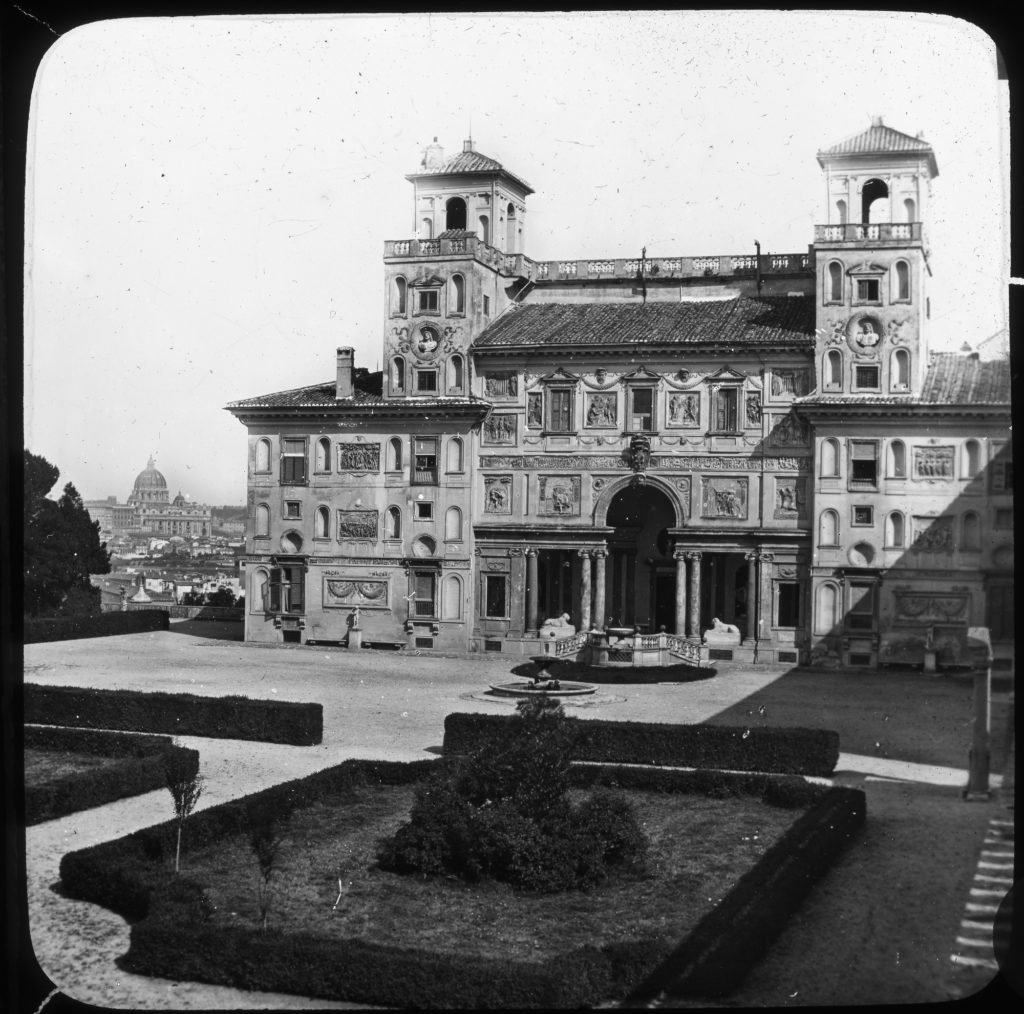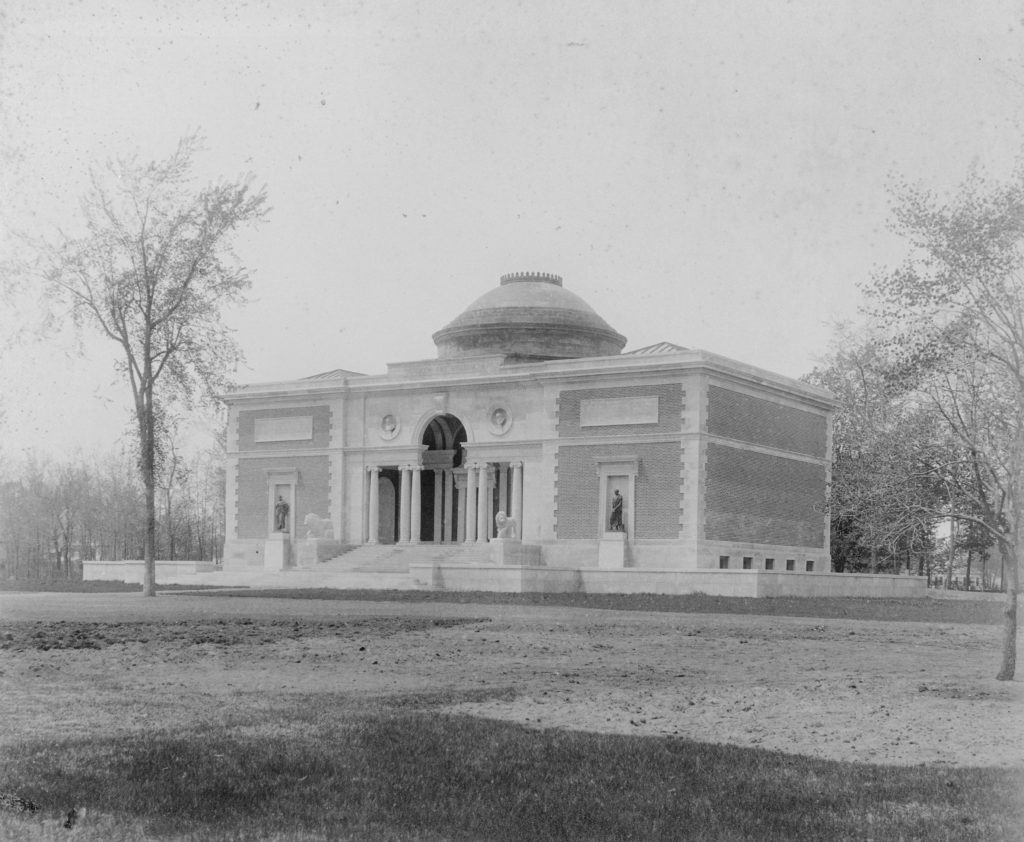Commission

Harriet Sarah Walker and Mary Sophia Walker, who commissioned the Walker Art Building in 1891 and were closely involved with its construction. (Robert Gordon Hardie, Portrait of Miss Harriet Sarah Walker, 1900, oil on canvas; and, Anna Elizabeth Klumpke, Portrait of Miss Mary Sophia Walker, 1895, oil on canvas. Bowdoin College Museum of Art, Bequest of Mary Sophia Walker, 1904.4 and 1904.3.)
Completed in 1894, the Walker Art Building was one of the first art museum buildings on an American college campus. The building was commissioned in 1891 by sisters Mary Sophia Walker (1839–1904) and Harriet Sarah Walker (1844–98) from the architectural firm of McKim, Mead, and White. In her letter inviting Charles McKim (1847–1909) to take on the commission, Harriet Walker wrote that the architecture of the building should “show the purpose for which it is to be used.” The Walker sisters consulted with McKim about every aspect of the building and approved all final details, from the exterior sculptures to the hanging of paintings. They remained steadfast in their commitment to creating a building dedicated “exclusively for art purposes”—a phrase enshrined in the deed of gift and in a bronze plaque in the building’s rotunda. For generations of Bowdoin students, the Museum’s architectural and decorative schemes have shaped their first impressions of and encounters with art history steeped in the ancient past.
The American Renaissance

The Villa Medici in Rome. G. Massiot & Cie, French Academy in Rome, ca. 1910, Lantern Slide. Courtesy of the Hesburgh Libraries at the University of Notre Dame. link
The late 19th century gave rise to the American Renaissance which positioned the United States as heir to the legacy and the ideals of the European Renaissance and the ancient cultures on which it was founded. The American Renaissance marked a high-water mark of classicism in the arts, and no finer expression of its principles can be found than in the Walker Art Building’s design and early collections. Charles McKim (1847–1909), who was responsible for the building’s design, trained at the École des Beaux-Arts in Paris before founding the architectural firm of McKim, Mead, and White in New York in 1877. By the time McKim began work on the Walker Art Building, his firm was already recognized as one of the country’s leading architectural firms and among the greatest proponents of the American Beaux-Arts style, which was in vogue during the American Renaissance period of art and architecture (1876–1917). From Filippo Brunelleschi’s mid-fifteenth century Pazzi Chapel in Florence, to Annibale Lippi’s Villa Medici (c. 1540) in Rome, numerous structures have been proposed as inspiration for McKim’s design, all of which derive from the Italian Renaissance.
Renaissance Architecture and Ancient Models

“Walker Art Building, Southwest View”, Local Call Number 2944. Courtesy of the George J. Mitchell Department of Special Collections & Archives, Bowdoin College Library, Brunswick, Maine.
As an exemplar of the American Renaissance movement in architecture, the Walker Art Building shows a clear debt to the Italian Renaissance and its ancient models. In plan, the building is laid out as a Greek cross, originally with three galleries arranged around a central, domed sculpture hall. This plan finds its closest renaissance models in the mid-fifteenth century Pazzi Chapel in Florence designed by renowned architect Filippo Brunelleschi. The Walker Art Building’s eastern façade, which faces the campus quad, is marked by a central loggia approached by a wide staircase. The loggia, inspired by the Medici Villa in Rome (c. 1540), is announced by three arches atop ionic columns, and its interior was originally painted in a style reminiscent of Pompeii frescoes. On either side of the loggia are niches that hold the bronze statues of the orator Demosthenes and the tragedian Sophocles, both of which are copies after ancient marbles and were ordered from the Neapolitan workshop of Sabatino de Angelis on the suggestion of the building’s architect Charles McKim. The inspiration for the pairing may likely be traced to the Boston Atheneum, where plaster casts of the same sculptures had been displayed as a pair since 1858. In a register above the loggia are busts of Hermes, Dionysus, and Homer, each also copied after ancient sculptures, as well as a pair of tablets bearing the names of major figures in Western art history from ancient Greece to Renaissance Rome. The names listed are a testament to the tastes of the American Renaissance movement and its central role of ancient art.
The Rotunda

Elihu Vedder, Rome (The Art Idea), 1894, oil on canvas. Bowdoin College Museum of Art, Gift of the Misses Harriet Sarah and Mary Sophia Walker, 1893.37.
The allusions to antiquity and the Renaissance that characterize the Walker Art Building exterior can also be found throughout the interior of the Museum. This is especially true of the rotunda gallery which was inspired by Roman antiquity and the Pantheon. At the time of the building’s commission, the architectural form of a rotunda was understood as the optimal design for displaying sculptures, and, in the earliest decades of its existence, the rotunda was filled with casts of ancient sculpture. The rotunda sculpture gallery is completed by four mural paintings that fill the large lunettes above each gallery entrance. For these murals, the Walker sisters and architect Charles McKim commissioned four of the country’s leading painters: Elihu Vedder (1836–1923), John La Farge (1835–1910), Abbott Thayer (1849–1921), and Kenyon Cox (1856–1919). Each had travelled extensively and trained in Europe, especially France and Italy, where the cultural output of the Renaissance and Greek and Roman antiquity was on display. These travels show in their choice of subject matter: allegorical treatments of the four major cities then understood as foundational in the evolution of (Western) art history: Rome (Vedder), Athens (La Farge), Florence (Thayer), and Venice (Cox). As framing devices for the galleries, the paintings have shaped the way in which art history is taught and received at the Museum for generations, even as the Museum collections have since grown to include important works of historic and contemporary art from across the world.